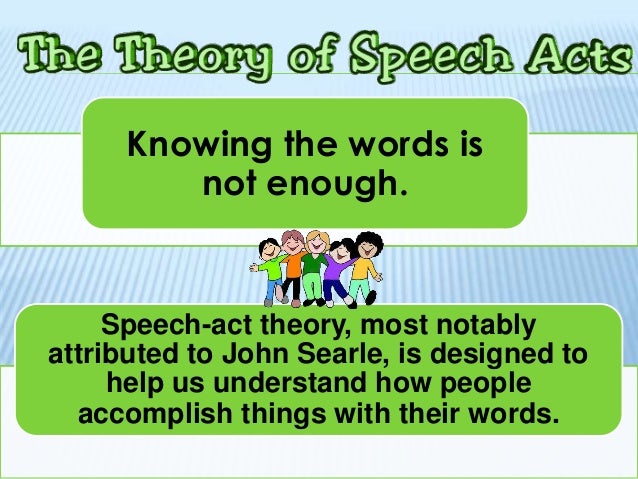Oral Communication

Speech acts might be requests, warnings, promises, apologies, greetings, or any number of declarations. As you might imagine, speech acts are an important part of communication.
Speech-Act Theory
Speech-act theory is a subfield of pragmatics.
This area of study is concerned with the ways in which words
can be used not only to present information but also to carry out
actions. It is used in linguistics, philosophy, psychology, legal and
literary theories, and even the development of artificial intelligence.
Speech-act theory was introduced in 1975 by Oxford philosopher J.L. Austin in "How to Do Things With Words " and
further developed by American philosopher J.R. Searle. It considers
three levels or components of utterances: locutionary acts,
illocutionary acts, and perlocutionary acts. Illocutionary speech acts
can also be broken down into different families, grouped together by
their intent of usage.Locutionary, Illocutionary, and Perlocutionary Acts
In order to determine which way a speech act is to be interpreted, one must first determine the type of act being performed. Austin categories all speech acts as belonging to one of three categories: locutionary, illocutionary, or perlocutionary acts.- Locutionary acts are, according to Susana Nuccetelli and Gary Seay's "Philosophy of Language: The Central Topics," "the mere act of producing some linguistic sounds or marks with a certain meaning and reference." However, these are the least effective means of describing the acts, merely an umbrella term for illocutionary and perlocutionary acts, which can occur simultaneously.
- Illocutionary acts, then, carry a directive for the audience. It might be a promise, an order, an apology, or an expression of thanks. These express a certain attitude and carry with their statements a certain illocutionary force, which can be broken into families.
- Perlocutionary acts, on the other hand, bring about a consequence to the audience if something is not done. Unlike illocutionary acts, perlocutionary acts project a sense of fear into the audience.Take for instance the perlocutionary act of saying, "I will not be your friend." Here, the impending loss of friendship is an illocutionary act while the effect of frightening the friend into compliance is a perlocutionary act.Families of Speech ActsAs mentioned, illocutionary acts can be categorized into common families of speech acts. These define the supposed intent of the speaker.

Comments
Post a Comment